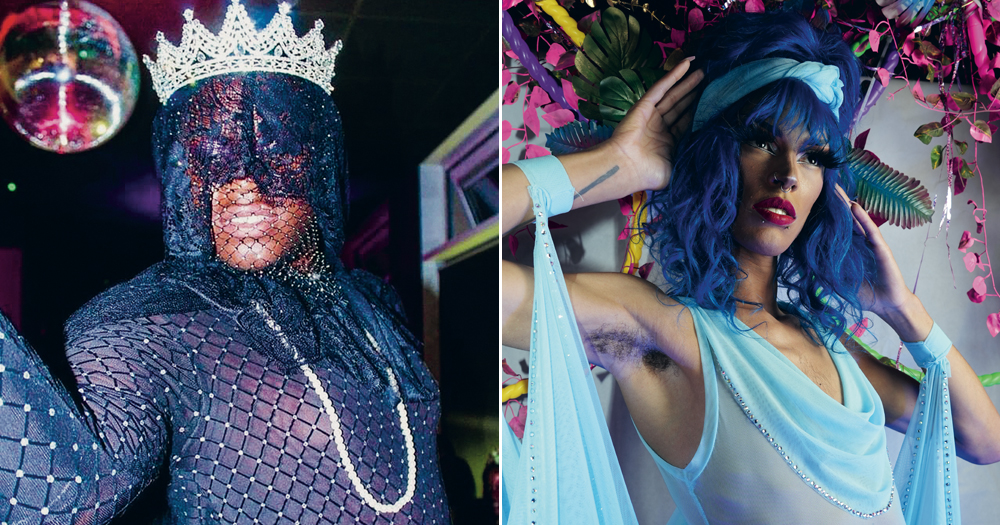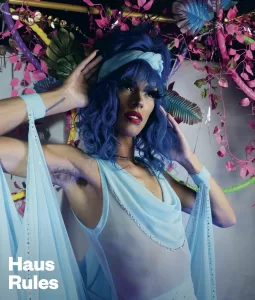In the grand tradition of Paris Is Burning, Ireland’s ballroom scene is officially open thanks to the incomparable Haus of Schiaparelli. Tracing back through the LGBTQ+ subculture’s history, Ethan Moser spoke to Haus Daddy Tino Wekare about the importance of ballroom for queer people of colour.
Launched in 2023 by Tino Wekare, the Haus of Schiaparelli broke ground last year when it hosted Ireland’s first-ever Black-led queer ball at Dublin’s Hen’s Teeth venue. The event brought traditional ballroom competition, as established in 1970s New York, to Ireland’s burgeoning LGBTQ+ scene, allowing queer people of colour to strut and dance down the runway in iconic mainstay categories such as ‘Coronation Runway’, ‘Best Dressed’, ‘MASC-ERADE’, ‘Alien Superstar’, ‘Face’, ‘Body’, ‘Twerkulator’, ‘Legwork Champion’, ‘Vogue’, and ‘Diamond of the Season’.
These categories, and others like them, are drawn directly from the annals of ballroom history, which traces its roots to 1920s New York City in an era known as the Harlem Renaissance. At the time, Black and Brown people gathered at New York’s Hamilton Lodge, a haven of social acceptance in a city that still criminalised expression of overt queerness, especially amongst communities of colour.
Ball culture at the Hamilton Lodge technically dates back to 1869, however, throughout the 1920s and 1930s – the true height of the Harlem Renaissance – ball culture attracted a wide range of spectators and performers, going beyond queer people of colour to include other artists and curious voyeurs.
Following the Harlem Renaissance, ballroom did not return in force until the late-1960s, when legendary trans drag queen Crystal LaBeija hosted some of the world’s first-ever ballroom events specifically for Black and Brown queer people. These new ballroom events took place in direct response to rampant ongoing racism in New York’s larger downtown drag scene. In 1972, Crystal officially established the Royal House of LaBeija, which is still operational today with 16 chapters scattered across the globe and notable members including RuPaul’s Drag Race and Legendary alum, Aja LaBeija.
Over the years, more and more drag ball houses would be established, including the iconic House of Balenciaga, the House of Xtravanganza, and perhaps most notably, the House of Dupree.
Founded by drag artist Paris Dupree, the House cemented itself as one of the most memorable in ballroom history after its founder was featured in Jennie Livingston’s 1990 documentary Paris Is Burning. The film, now a landmark of queer culture, was named after the House’s annual drag ball.
The likes of the Houses of LaBeija, Balenciaga, and Dupree would go on to inspire countless others to establish their own ballroom families to compete in a variety of extravagant runway categories, including Dublin’s own Haus of Schiaparelli.
Visualizza questo post su Instagram
The Haus, which now boasts six members, most of whom were directly inducted by Haus Daddy Tino, gets its name from acclaimed Italian fashion designer Elsa Schiaparelli. Known for her fearless audacity and ability to push the boundaries of fashion, the late designer’s haute-couture fashion house is still operational, dressing high-profile celebrities for high-profile events such as Lady Gaga (at US President Joe Biden’s 2021 Inauguration), Beyoncé (at the 2023 Grammy Awards), Bella Hadid (at the 2021 Cannes Film Festival), and Cardi B (for Paris Fashion Week 2023), amongst others.
The Haus of Schiaparelli is similarly defined as a ‘Kiki House’ – a less competitive version of the legendary likes of LaBeija and Dupree. Kiki houses were originally established as an underground community specifically for queer young people. They were created to provide a youth-only space that was more economically accessible and less competitive. Additionally, kiki houses allowed for disowned, lost, and orphaned queer youth of colour to forge surrogate-family structures where radical acceptance was a given. These quasi-familial relationships between house founders and members popularised the use of terms such as ‘House Mother’ or, in the case of the Haus of Schiaparelli, ‘Haus Daddy’.
Speaking on the importance of bringing ballroom to Ireland, Haus Daddy Tino told GCN: “It is important that Black and Brown queer people have artistic spaces where they can practise self-expression, and what makes ballroom so important is that this is our space.
“Ballroom was founded by Black and Brown people, for Black and Brown people. It is a space that prioritises us in a way that other queer spaces do not. The importance of spaces like this is that it allows queer people of colour not to feel like an afterthought.
“It allows us to be creative and have fun highlighting our joy in a world that focuses on Black and Brown suffering,” Tino continued.
Visualizza questo post su Instagram
Self-expression, according to Tino, is a key facet of what makes ballroom so important for queer people of colour in Ireland and around the world. The Haus Daddy describes ballroom events as “a dynamic fusion of dance, fashion, and performance art,” that empowers “marginalised individuals to assert their identities and share their stories of struggle and triumph, fostering a space of authenticity and celebration. [Ballroom] allows for recognition through scores, trophies, and the respect earned within the community, validating participants’ efforts and contributions. It is a vibrant expression of art, identity, and community, celebrating the true selves of its participants.”
Since its establishment, the Haus of Schiaparelli has hosted a few events, each bigger and better than the last. While the balls always feature a number of categories for participants to strut down the runway in, Schiaparelli’s events similarly include an ‘MVP’ category, awarded in honour of a participant who the event’s judges feel has “impacted our community in a generally positive way.” Voguing is also something that can be expected at every Haus of Schiaparelli ball, and really, any ballroom event around the world. Brought into the mainstream by artists like Madonna with her 1990 hit song ‘Vogue’, the highly-stylised dance was birthed in Harlem by Black and Brown communities, and named after Vogue magazine as it was inspired by the poses of fashion models.
The dance, often given its own category at ballroom events, allows competitors to take the stage and demonstrate the six elements of vogue – catwalking, duckwalking, hand performance, spins, dips, and floor performance.
In an Instagram post announcing its 2023 ball at Hen’s Teeth, the Haus of Schiaparelli invited participants to join in its ‘Vogue’ category, telling them: “Your task is to embody the spirit of vogue and present a performance that combines elements of precision, athleticism, and storytelling. Showcase the six elements of vogue… with your unique flair and personal style. Whether you’re inspired by the old way or [the] new way…Let your body become a vessel for creative expression, fluidly transitioning between poses and movements that defy convention. This is your moment to shine as a vogue pioneer, leaving an indelible mark on the world of ballroom and beyond.”
Speaking further on what spectators can expect from a Haus of Schiaparelli ball, Tino proclaimed: “No two nights are ever the same. The performers always give it their all and there is always something new to expect.”
Looking to the future, the Haus of Schiaparelli informed GCN that it will soon begin hosting a variety of ballroom-themed workshops covering everything from performance to history. To keep up with all of the jaw-dropping, show-stopping ballroom eleganza that the incomparable Haus of Schiaparelli is putting on, be sure to check out their Instagram at @hausofschiaparelli.
© 2024 GCN (Gay Community News). All rights reserved.
This article was published in the print edition Issue No. 385 (August 1, 2024). Click here to read it now.
Support GCN
GCN is a free, vital resource for Ireland’s LGBTQ+ community since 1988.
GCN is a trading name of National LGBT Federation CLG, a registered charity - Charity Number: 20034580.
GCN relies on the generous support of the community and allies to sustain the crucial work that we do. Producing GCN is costly, and, in an industry which has been hugely impacted by rising costs, we need your support to help sustain and grow this vital resource.
Supporting GCN for as little as €1.99 per month will help us continue our work as Ireland’s free, independent LGBTQ+ media.

